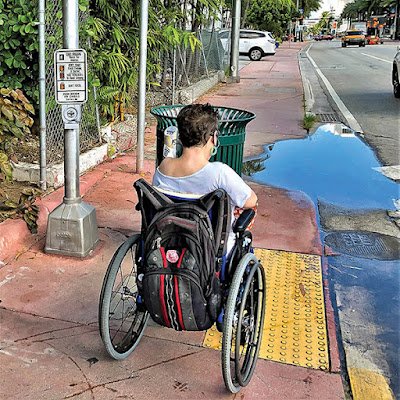THE CRAPPY CURB RAMP
One-size-fits-all is never the answer.
When cities put a single, narrow curb ramp at an intersection, it's more than uncomfortable — it's downright life-threatening.
Curb ramps must be at least three feet wide,
with no more than a 1 to 12 (8.3 percent) grade, according to ADA guidelines.
Local
conditions, like a high step up to the curb or a bike lane, might even call for
more thoughtful design.
Other curb
ramp issues include street furniture and other barriers on or at the top of the
ramp, flooding at the street edge due to poor drainage, and street repairs
where contractors demolish ramps, even temporarily.
Too-narrow
curb ramps force those who use wheelchairs, scooters, and other assistive
mobility devices to roll partway into oncoming traffic.
That can be
incredibly dangerous.
Think about
the height of a wheelchair user: The standard seat is 21 inches tall, placing
the user's midsection about the same height as an SUV (SUVs are exempt from the
maximum sedan bumper height of 20 inches).
Then think
about how high the driver of an SUV or truck sits.
A wheelchair
user needs to be seen to be safe, but depending on the vehicle and
intersection, some are completely obstructed from view.
An Insurance
Institute for Highway Safety found pedestrian traffic fatalities rose by 53
percent from 2009 to 2018.
The same
study found that at speeds between 20 and 39 mph, 30 percent of pedestrians
struck by SUVs died.
The best
solution is a pair of curb ramps at each corner: one aligned perfectly with the
painted north-south crosswalk, and the other matched to the east-west one.
The curbs
act as continuations of the sidewalk into the crosswalk.
A very wide,
continuous curb ramp that spans the entirety of a corner is also a best
practice.

No comments:
Post a Comment